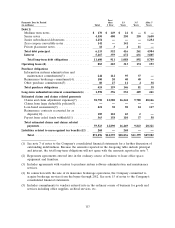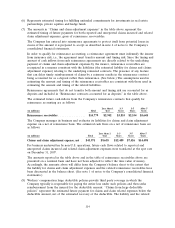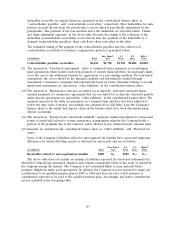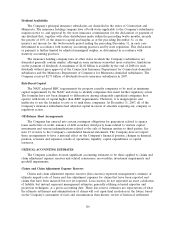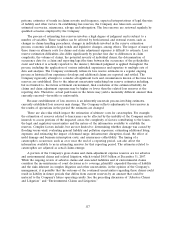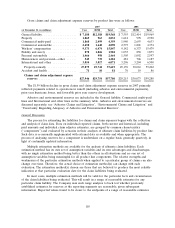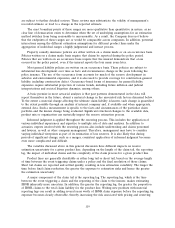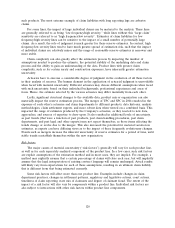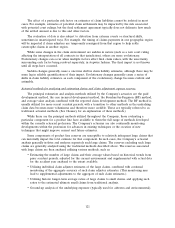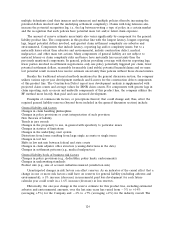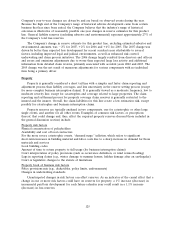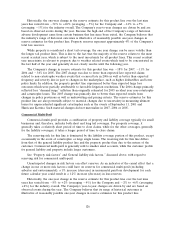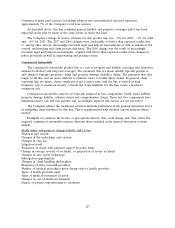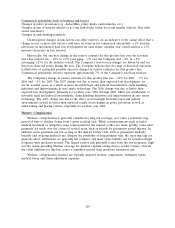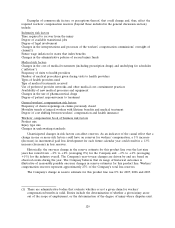Travelers 2007 Annual Report Download - page 132
Download and view the complete annual report
Please find page 132 of the 2007 Travelers annual report below. You can navigate through the pages in the report by either clicking on the pages listed below, or by using the keyword search tool below to find specific information within the annual report.
such products. The most extreme example of claim liabilities with long reporting lags are asbestos
claims.
For some lines, the impact of large individual claims can be material to the analysis. These lines
are generally referred to as being ‘‘low frequency/high severity,’’ while lines without this ‘‘large claim’’
sensitivity are referred to as ‘‘high frequency/low severity’’. Estimates of claim liabilities for low
frequency/high severity lines can be sensitive to the impact of a small number of potentially large
claims. As a result, the role of judgment is much greater for these reserve estimates. In contrast, high
frequency/low severity lines tend to have much greater spread of estimation risk, such that the impact
of individual claims are relatively minor and the range of reasonable reserve estimates is narrower and
more stable.
Claim complexity can also greatly affect the estimation process by impacting the number of
assumptions needed to produce the estimate, the potential stability of the underlying data and claim
process and the ability to gain an understanding of the data. Product lines with greater claim
complexity, such as for certain surety and construction exposures, have inherently greater estimation
uncertainty.
Actuaries have to exercise a considerable degree of judgment in the evaluation of all these factors
in their analysis of reserves. The human element in the application of actuarial judgment is unavoidable
when faced with material uncertainty. Different actuaries may choose different assumptions when faced
with such uncertainty, based on their individual backgrounds, professional experiences and areas of
focus. Hence, the estimate selected by the various actuaries may differ materially from each other.
Lastly, significant structural changes to the available data, product mix or organization can also
materially impact the reserve estimation process. The merger of TPC and SPC in 2004 resulted in the
exposure of each other’s actuaries and claim departments to different products, data histories, analysis
methodologies, claim settlement experts, and more robust data when viewed on a combined basis. This
impacted the range of estimates produced by the Company’s actuaries, as they reacted to new data,
approaches, and sources of expertise to draw upon. It also resulted in additional levels of uncertainty,
as past trends (that were a function of past products, past claim handling procedures, past claim
departments, and past legal and other experts) may not repeat themselves, as those items affecting the
trends change or evolve due to the merger. This also increased the potential for material variation in
estimates, as experts can have differing views as to the impact of these frequently evolutionary changes.
Events such as mergers increase the inherent uncertainty of reserve estimates for a period of time, until
stable trends reestablish themselves within the new organization.
Risk factors
The major causes of material uncertainty (‘‘risk factors’’) generally will vary for each product line,
as well as for each separately analyzed component of the product line. In a few cases, such risk factors
are explicit assumptions of the estimation method and in most cases, they are implicit. For example, a
method may explicitly assume that a certain percentage of claims will close each year, but will implicitly
assume that the legal interpretation of existing contract language will remain unchanged. Actual results
will likely vary from expectations for each of these assumptions, resulting in an ultimate claim liability
that is different from that being estimated currently.
Some risk factors will affect more than one product line. Examples include changes in claim
department practices, changes in settlement patterns, regulatory and legislative actions, court actions,
timeliness of claim reporting, state mix of claimants and degree of claimant fraud. The extent of the
impact of a risk factor will also vary by components within a product line. Individual risk factors are
also subject to interactions with other risk factors within product line components.
120





